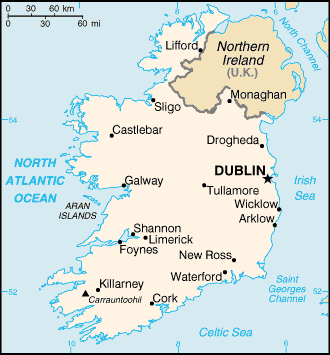Map:

Overview:
Celtic tribes arrived on the island between 600-150 B.C. Invasions by Norsemen that began in the late 8th century were finally ended when King Brian BORU defeated the Danes in 1014. English invasions began in the 12th century and set off more than seven centuries of Anglo-Irish struggle marked by fierce rebellions and harsh repressions. A failed 1916 Easter Monday Rebellion touched off several years of guerrilla warfare that in 1921 resulted in independence from the UK for 26 southern counties; six northern (Ulster) counties remained part of the United Kingdom. In 1948 Ireland withdrew from the British Commonwealth; it joined the European Community in 1973. Irish governments have sought the peaceful unification of Ireland and have cooperated with Britain against terrorist groups. A peace settlement for Northern Ireland, known as the Good Friday Agreement and approved in 1998, is being implemented with some difficulties.
The People:
Population: 4,015,676 (July 2005 est.)
Age structure:
0-14 years: 20.9% (male 434,225/female 406,730)
15-64 years: 67.5% (male 1,358,086/female 1,354,148)
65 years and over: 11.5% (male 203,614/female 258,873) (2005 est.)
Religions:
Roman Catholic 88.4%, Church of Ireland 3%, other Christian 1.6%, other 1.5%, unspecified 2%, none 3.5% (2002 census)
Government Type:
republic
Leader(s) to pray for:
chief of state: President Mary MCALEESE (since 11 November 1997)
head of government: Prime Minister Bertie AHERN (since 26 June 1997)
Source: The World Factbook
View All Countries